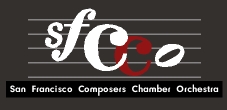Hello Symphony at Goat Hall |
| JEFF
DUNN |
||||||
| San Francisco Composers Chamber Orchestra, conducted by John Kendall Bailey and Mark Alburger, performs Tom Heasley's New Work for Tuba and Electronics, Stan McDaniel's Duet 1993 ("Remembrance"), Alexis Alrich's Fuse for Oboe, Percussion, Piano, and Strings, Marcia Burchard's Chartres Cathedral Labyrinth, John Beeman's Beeline: A Festival Overture, Erling Wold's Martyrium Pilati from Sub Pontio Pilato, and Alburger's Symphony No. 1 ("It Wasn't Classical..."). March 22, Goat Hall, San Francisco, CA. "This is a Hello Symphony!" exclaimed Music Director Mark Alburger, referring to how more and more members of the San Francisco Composers Chamber Orchestra would troop to the stage as the evening progressed, the opposite of Haydn's "Farewell" concept. Indeed, the pleasures of greeting far more closely matched the moods of the seven compositions than the despondencies of leave-taking. The large crowd -- packed tightly enough into Goat Hall to make goat cheese -- was in for a jolly good time. The evening began with Tom Heasley performing an unnamed solo tuba improvisation, enhanced by electronic processing. Each note he played was transformed (perhaps by amplifying the partials) into a triad with reverb. The widely spaced chords emerged ethereally, generating a hypnotic state readily analogous to a luxuriant, palate-cleaning appetizer, leaving the audience relaxed and receptive. Stan McDaniel's Duet 1993 (Remembrance) for violin and cello followed, consisting of three short movements, (legato, jaunty, soulful) characterized by now-you-hear-them-now-you-don't implied tonalities. Alexis Alrich then began firing up the atmosphere with her Fuse for Oboe, Percussion, Piano and Strings. The fusion here seemed to be with various world musics, represented by an accompanying drone and catchy dance rhythms. A nod to Western influences was apparent in the modulatory central sections. Altogether, a rousing endeavor greatly appreciated by those in attendance. The first half of the "Hello" concluded with excerpts from Marcia Burchard's Chartres Cathedral Labyrinth, a work celebrating a famous maze, the walking of which is considered a method of spiritual contemplation. The design for the maze can become a springboard for extensive numerological investigation, details of which were explored extensively by the composer. To her credit, enjoying the music requires no knowledge whatsoever of the maze itself, or the 1 0 Sefirot of the Kabala which provide inspiration for the movements. Three of the movements were performed -- "Malkuth," "Yesod," and "Tiphareth." A passacaglia ("Yesod") was the most effective. Each note of the tune represented one of the seven 180-degree turns one must negotiate in each of the maze's Cross-defining quadrants. Orientalisms abound in the music, the style of which sometimes sounds like Alan Hovhanness. The second half began with John Beeman's Beeline: A Festive Overture. Beeman wisely rejected an earlier working title, Flash in the Pan. The piece starts off with a fine enough flash, but then the heat is turned down for a much slower central interval before the sparky seesaw main theme recapitulates. Hopefully Beeman's work will become more than its erstwhile working title and be performed someday by a full orchestra, thus allowing for some issues of balance to be better addressed. The conclusion to Erling Wold's opera Sub Pontio Pilato was next on the agenda. The Coptic view that Pontius Pilate later became Christian and was martyred is given grandiose treatment in a postminimalistic yet Symphonyof-Psalms kind of way. The sustained effect of the music was masterful, bringing forth enthusiastic applause. The whole opera will definitely be worth checking out when it's performed next year in San Francisco. The evening's final "Hello" was the West Coast premiere of Mark Alburger's Symphony ("It wasn't classical, it was symphonic ... It wasn't a symphony, because it did not have a sonata-allegro"), op. 21. This is part of a series contemplated by Alburger in which each numbered symphony is based on the structure of a like-numbered symphony by another composer. This First was modeled on Beethoven's. The subtitle is commentary by a witness to Gorecki's conducting of his best-selling Third Symphony in California in 1998. Ironic commentary, for Alburger's delightful work is a symphony in every way. And not YET a runaway best seller, but who knows? Alburger is the closest thing to a reincarnation of George Antheil since H. K. Gruber. You never know what piece of cultural flotsam will be tossed at you next. The first movement is full of fun and syncopation in the spirit of Milhaud or even Don Gillis. The lilting rhythms of Bernstein's song "America" pop in and out. In the second movement, the best of the bunch, a rather toowell-behaved stepwise tune develops a hiccup that morphs into the subject of a development section. In the third, misnamed "Menuetto" (Just as Beethoven's is incorrectly characterized), Alburger evokes a fast-paced, strongly accented triple meter reminiscent of Strauss's chasing down the troublemaker Til Eulenspiegel. This all-to-short charmer precedes an even more frantic, somewhat ungainly vivace conclusion, made all the more exciting by Alburger's energized, nearly comic conducting style. Such a satisfying evening that one was reluctant to say goodbye to the Hello concert, but let's hope that this bunch of happy music-makers has more in store, and that the musical elite of San Francisco will all go to Goat Hall, next time around!
|
||||||
 |
